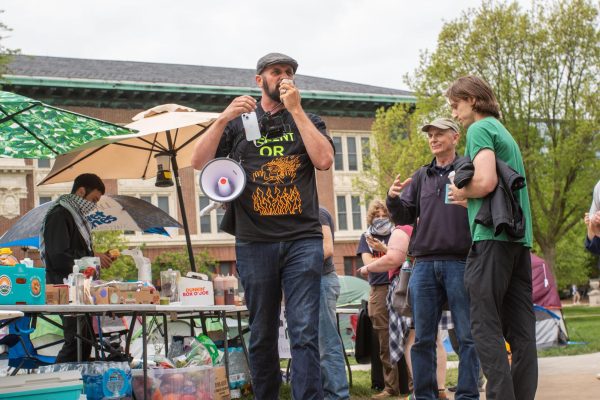Local police departments alert community of sexual assaults, batteries
October 20, 2014
Two sexual assaults at 309 E. Green St., along with four to five aggravated batteries, that occurred on Oct. 11 sparked concern and questions on campus.
Champaign Chief of Police Anthony Cobb said the crime that weekend was very uncommon, but added that there is a typical spike in crime every fall. However, Cobb said that the two sexual assaults on Green Street were particularly rare because most assaults on campus are date rape sexual assaults, rather than strangers approaching an individual.
The Champaign Police Department and the University Police Department work closely together to ensure safety on campus and since the incidents, have started an increased police presence in the locations where the assaults took place.
“Students need to be aware of the crime and reduce their chances of being a victim,” Cobb said. “For example, both assaults took place in apartments where the door was unlocked. When you are in your apartment lock the doors.”
University crime alerts
Get The Daily Illini in your inbox!
Crime alerts, which began around five years ago, serve as a connection between the police departments and members of the University and community.
There are two categories for email alerts: a public safety advisory, which serves as a warning to the community, and a crime alert, which is used to report recent crime activity.
The category of crime alerts is mandated by the Clery Act, which mandates information regarding crime that must be shared by the police. This act also states the need to send an alert based on the location of the crime.
The police have a list of offenses that they refer to when deciding whether or not a crime should be alerted through email.
For example, the robbery that occurred on Oct. 12 took place inside the Illini Union. Because the Union is owned by the University and located on campus, the police department was required to report this crime. The batteries that occurred at 309 E. Green St. that same weekend were not located on a part of campus recognized by the Clery Act, but an alert was still sent out.
“We feel it is in the interest of the community that if there is a crime that is an ongoing pattern and could be a safety threat, students, staff and visitors should be alerted,” Matt Myrick, University Police lieutenant, said. “The alert will help them to take appropriate precautionary measures such as locking doors to avoid a break-in.”
Myrick said the police department has developed protocols of when to send out crime alerts through email. He said that while the police would like to send the alerts out as soon as possible, there are times when an email is delayed in order to ensure all the information is included. Some events begin with a 9-11 call and by the time the report is sent out, the initial description given to 9-11 has been altered and new information has been received.
The batteries that occurred on Oct. 11 serve as an example of an alert needing to be held off until all the information was known. When all four incidents were reported, it was not until all suspect descriptions were reviewed that they could reported that the incidents were related.
“… With the evolving technology and the ability to send out mass emails, we feel strongly that we want the community to be aware of any potentially dangerous ongoing events,” Myrick said. “Part of that is we need the community’s help to solve some of these crimes. We want people to be aware and have the information and even video to help us find the suspect.”
Myrick also said that it is important that the police not only send out crime alerts, but alert when a suspect has been arrested. The intent is that alerts encourage students and community members to help the police locate suspects and ultimately, send a message to criminals that they cannot get away with crime.
College Bound Safe and Sound
College Bound Safe and Sound is a program started by Chicago Police Officers Jack Shilney and Josh Weitzman that aims to teach high school and college students to be aware of their personal safety and surroundings while on campus. The program provides information focused on sexual assault statistics, preventative measures and dorm safety.
“We started College Bound Safe and Sound because there are so many sexual assaults in the news and media that we wanted to give high school and college students a chance to be proactive about their safety,” Shilney said.
One focus of the program is the “red zone,” which refers to the time period between the start of school and Thanksgiving break.
This period is when girls are more likely to be the victim of a sexual assault on campus due to the newness of college and lack of parental supervision.
“Our motto is to stay out of the red zone and be aware of it,” Shilney said.
Shilney said that this is the time for students to be most aware of crime and take precautions to reduce their risk of being a victim while on campus.
“The red zones pertain mostly to sexual assault, but if there is high crime in certain areas, hopefully the school and local police can figure out a way to cure the crime,” Shilney said.
Another focus of the program involves fraternities and sororities, as on-campus sexual assaults occur more often at fraternity parties, according to College Bound Safe and Sound.
The program said alcohol, which is commonly found at fraternity parties, is the number one date rape drug. Shilney added that girls that are in a sorority are 74 percent more likely to become a victim of sexual assault.
The program therefore aims to teach sororities and fraternities to help both male and female students remain safe while going out and how to avoid becoming a victim of assault.
Elyssa can be reached at [email protected].






